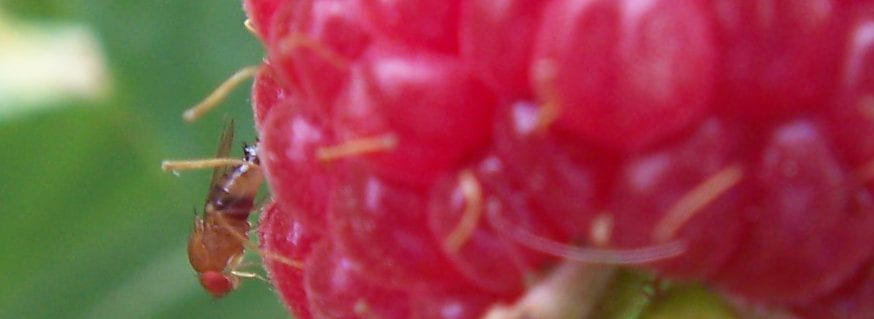On Thursday, March 10, 2022, from 11:30 to 12:30, I will present our work on using hummingbird feeders to attract Ruby-throated Hummingbirds into raspberry plantings as an aid in managing SWD. This seminar will be part of the NYS IPM Program's Seminar Series. To learn more about the NYS IPM Seminar series and upcoming talks, visit nysipm.cornell.edu/resources/nysipm-seminars/.
My seminar will be presented via zoom, so you can join and watch from the comfort of your home office or wherever you are using this zoom link:
cornell.zoom.us/j/97142846187?pwd=c0hNbldOR3ZXbFF0eVgzc2YybUMzUT09 https://cornell.zoom.us/j/97142846187?pwd=c0hNbldOR3ZXbFF0eVgzc2YybUMzUT09
Here is a summary of our work on hummingbirds, which I will present on March 10, 2022 at 11:30 to 12:30.
Hummingbirds require arthropods in their diet and may consume 2000 small insects, including Drosophilids, per day when fledging young. In New York State, we investigated the use of feeders to attract Ruby-throated Hummingbirds into raspberry fields to encourage predation of spotted-wing Drosophila (SWD) with the goal of reducing fly populations and fruit infestation. Baited traps were used to assess fly populations and salt flotation was used to assess fruit infestation. Over four years (2015-2018), 81% of 266 hourly observations of hummingbird behavior found the birds were occupying the raspberry planting when utilizing the feeders, supporting opportunities for predation on SWD flies. In 16 out of 18 weeks in 2017 and 2018, the number of SWD found in fruit were reduced in the half of the field with 62 feeders/hectare (25/A), compared to the half without feeders. We found a significant season-long reduction of 27% in average fruit infestation in 2017, a year with high populations of SWD. Trap catch was lower in the feeder half of the field in 15 of 25 weeks in 2016-2018. In two 0.035 ha (0.09 A) commercial raspberry fields (2020), in the one with 151 feeders/hectare (54/A) significant reductions in trap catch were found in most weeks during the fruiting season compared to the field without feeders. No Ruby-throated Hummingbirds were observed in the commercial field without feeders. Hummingbirds may protect fruit against SWD when encouraged with feeders to visit and occupy raspberry plantings. Encouraging hummingbirds in raspberry fields with feeders has the potential for contributing to an SWD IPM program and reducing the reliance on chemical management.

Want to learn more about how to use hummingbird feeders in your raspberry plantings? Contact Juliet Carroll, jec3@cornell.edu, Fruit IPM Coordinator, NYS IPM Program, Cornell University. Collaborators on this project included: Percival M. Marshall, NYS IPM Program, Nicole E. Mattoon, NYS IPM Program, Courtney A. Weber, Horticulture, and Greg M. Loeb, Entomology.


This is encouraging information! Thank you for conducting this research! I would like to apply your findings to my 18-bush blueberry patch that I usually cover with bird netting to protect the berries. I have never found a hummingbird entangled in the netting, which is a sturdy black plastic 0.75" X 0.75" mesh, which I'm guessing is too small to allow safe passage of a hummingbird. Is there an optimal mesh size that safely allows hummers in and out but excludes other birds out? Most of the birds that are after the berries are quite large - catbirds, orioles, robins. Or is netting a hummingbird nightmare, no matter the size and stiffness? Thanks, Carol
Bird netting would not be conducive to hummingbird predation of SWD. The netting would prevent the hummingbirds to continue to use the hummingbird feeders you placed in the blueberry planting. In order to enter through the netted planting, the netting would need to be about 3" x 3", if not wider. Bird netting is highly effective against fruit-eating birds. Other bird damage management tactics that might not discourage hummingbirds from visiting feeders placed in a blueberry planting are available and include scare tape, scare balloons, plastic owls, bird distress call boxes, air pistols that make a screaming sound, air canons, and air dancers. Air dancers are the large blowing people often seen at used car dealerships, although very effective, they require electricity or gas-powered air pumps and may scare your dogs. More information on bird damage management in blueberry is available at https://blogs.cornell.edu/berries/ipm/blueberry-ipm/#wildlife.